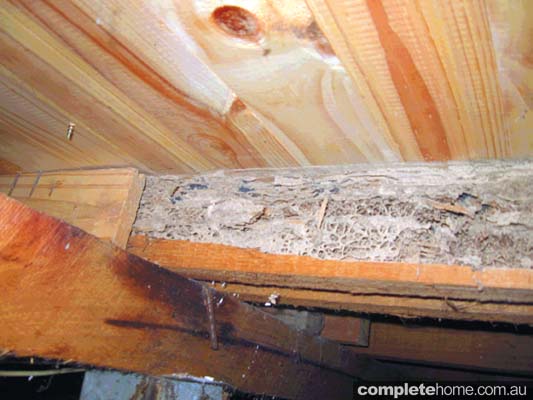What are the top 10 most expensive home repairs? This guest post from Complete Home answers that question.

Avoid having to make costly repairs to the home you’ve just purchased with Archicentre’s top 10 most expensive home repairs checklist, and potential traps summary.
Did you know? According to Archicentre an estimated 80 percent of Australian property transactions take place without the purchaser inspecting for structural or termite problems.
Buying a property is a complex exercise and if people purchase a property that has major faults, it can lead to a major personal and financial crisis. To limit the risk of financial stress in purchasing a home prior to making an offer, arrange a pre-purchase property inspection from an independent, professional and trained person such as a structural engineer or an architect to ensure the house is safe and sound.
Homebuyers need to be methodical and realistic when purchasing a home, as there is little room for making a mistake without serious consequences. A professional inspection of the home will assist buyers in determining the condition of the property and the cost of repairs to provide them with a bargaining tool and to enable them to factor in repair or maintenance costs into their budgets. Health and safety risks exist in about one-quarter of older Australian homes, and potentially expensive hidden defects exist in about one in three properties.
The top 10 most expensive home repairs:
1. Re-stumping
People interested in purchasing a home can get some inkling of this fault if they hear glasses rattle in the sideboard or flowers shake on the table when they walk through the home. Without a proper inspection of the sub-floor area, it is impossible to obtain a clear indication of the state of the stumps.
Archicentre inspectors, when inspecting the sub-floor areas, have found a range of approaches to try and cover up dodgy stumps, including wedging pieces of scrap timber between stumps and bearers, temporary props wedged under bearers sitting on bricks, and stacks of bricks under bearers.
2. Roofs
The roof is one of the most important parts of the home that receives scant attention from most homebuyers, despite roof faults costing tens of thousands of dollars to repair. With heavy rain, a leaking roof, a cracked roof tile or poorly fitted guttering can have a major impact on the interior of a home, and also on safety if water penetrates the electrical wiring. Archicentre inspectors have reported a number of roof cover ups.
The most common being a quick fix for the rusty roof with the roof painted to cover up the rust, often with the rust re-appearing soon after settlement.
An inspection inside the roof cavity is a good indication of the structural soundness of the roof and to observe probable leaks, especially through holes in the roof, which may be temporarily plugged up with silicon.
3. Wiring
Blackened areas on power points are one of the first give-away signs that all is not well with a home’s wiring. Wiring is a vital part of the home and must be installed by licensed electricians that are registered to ensure the installation is carried out to correct standards and is safe.
Unfortunately, some homeowners carry out illegal wiring in the belief they can cut costs. Often the work is carried out in roof spaces or under the floor areas where homebuyers, who do not have an inspection, are not able to access. Apart from illegal wiring, buyers of older homes may face the issue of renewing all wiring and adding safety switches.
4. Pest management
When some homeowners are confronted with the realisation that their home is infested by termites and that the eradication and damage cost will be expensive, they decide instead to sell their homes and, in some cases, take steps to conceal the problem.
Some of the traps facing prospective homebuyers:
- A mattress placed on the floor and heavy boxes strategically placed to conceal termite damage.
- Access hatches to the sub-floor nailed shut to prevent access.
- Access hatch to the ceiling nailed shut to prevent access.
- Patches nailed over severely affected floorboards and then carpeted.
- Skirtings and architraves patched and painted to conceal damage.
- Rooms being locked during inspection times apparently “because they contained valuables”.
5. Plumbing
Plumbing can be a major cost, especially in older homes, where the total replacement of old rusted pipes can be necessary at substantial costs with significant inconvenience, added to the equation. People inspecting homes should test the water pressure by turning on a couple of taps at once to see what water pressure is available and whether the water is discoloured.
Plumbing needs to be undertaken by a licensed plumber to ensure it is safe and correctly installed; however, again often there are many homes where illegal work has been carried out.
During pre-purchase inspections, Archicentre architects have found make-shift drains or leaking pipes under homes that have resulted in damp areas that are a magnet for termites and can cause major expensive damage to the building’s structure if not detected.
6. Painting
Painting is often thought of as an area that can be a DIY task. If you buy a home where painting has been a quick cover up exercise and there has been a lack of preparation or skimping on the undercoat or quality of paint, you can face a hefty bill to repaint the affected areas.
7. Plastering
Plastering repairs can vary from the filling of minor cracking to major patch-ups where re-stumping is concerned, or where a home has been inundated with water. The replacement of termite affected framing will also require major re-plastering.
8. Rising damp
Rising damp occurs as a result of capillary suction of moisture from the ground into porous masonry building materials such as stone, brick, earth and mortar. Damp walls encourage the growth of moulds, which with high humidity, can lead to health problems for occupants.
9. Guttering and downpipes
Rusted out, poorly maintained or badly fitted guttering can lead to major problems for a new homeowner as during storms heavy rain can result in water entering the home and damaging plaster, flooring, cabinets and also potentially impacting on electrical services.
10. Stormwater drains
Underground pipework is not usually high on a homebuyer’s agenda when looking at a home for purchase, however, stormwater drains and sewer pipes play a vital role in the home being able to function and can be costly to repair, not to mention the danger that leaking pipes can cause.
Archicentre, the building design, inspection and advice service of The Australian Institute of Architects has a free Cost Guide on its website at archicentre.com.au/cost-guide, which provides an indication of costs for renovation and repairs.
The Property Renovation Library | The Property Renovation Video Hub
By Ian Agnew
From Renovate magazine Vol. 9 No. 2


